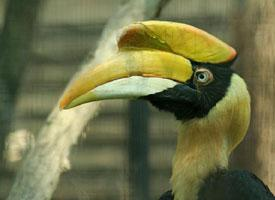
Also known as
- Dvojzoborožec indický
- Dvojzoborožec velký
Weights and measures
| Height at the shoulder | from 1,2 to 1,5 m |
|---|---|
| Weight | 3 kg |
Animal description
The Great Hornbill (Buceros bicornis), also known as the great Indian hornbill or the great pied hornbill, is an impressive and majestic bird that is native to the forests and tropical regions of the Indian subcontinent, Southeast Asia, and the Malay Peninsula. This bird is one of the larger members of the hornbill family, which is known for its distinctive features and behaviors.One of the most striking characteristics of the Great Hornbill is its vibrant and sizable casque-topped beak. The beak is a bright yellow and black color, with a large, hollow, helmet-like structure known as a casque on the upper mandible. This casque is thought to be used in mating rituals and dominance displays, as well as possibly having a role in amplifying the bird's calls. The beak is not only an ornament but also a highly effective tool for foraging, allowing the bird to reach into crevices and pull out prey.
The Great Hornbill is a large bird, typically measuring between 95 to 130 cm (37 to 51 inches) in length, with a wingspan that can reach up to 150 cm (59 inches). The males are usually larger than the females and have a more prominent casque. They weigh between 2 to 4 kg (4.4 to 8.8 lbs), making them one of the heaviest flying birds in the forest canopy.
The plumage of the Great Hornbill is predominantly black and white. The body and wings are mostly black, with white markings on the wing coverts and tail feathers. The tail is long and has a unique white band across it, which is conspicuous during flight. The neck is adorned with a fluffy, white collar which gives the bird a regal appearance. The eyes are encircled by a patch of bare skin, which is typically red or pink in color, adding to their striking visage.
Great Hornbills are known for their loud, echoing calls that can be heard over long distances in their dense forest habitats. These calls serve as a means of communication between individuals and play a role in maintaining pair bonds as well as in territorial defense.
These birds are predominantly frugivorous, meaning their diet consists mainly of fruit. They play a crucial role in their ecosystems as seed dispersers, consuming fruits whole and later excreting the seeds far from the parent tree, thus aiding in forest regeneration. However, they are also known to eat small mammals, birds, insects, and reptiles, making them opportunistic feeders.
One of the most fascinating aspects of the Great Hornbill's behavior is their breeding ritual and the unique way they nest. When ready to lay eggs, the female finds a tree cavity and seals herself inside using feces and mud, leaving only a narrow slit through which the male feeds her throughout the incubation period. The male's role is vital during this time, as he must bring enough food for the female and the chicks until they are ready to leave the nest.
The conservation status of the Great Hornbill is currently listed as Vulnerable by the IUCN Red List due to habitat loss and hunting for their casques and meat. Conservation efforts are in place to protect these magnificent birds, including habitat preservation and anti-poaching measures.
In summary, the Great Hornbill is an iconic species with a unique morphology and intriguing behaviors. Its role in the ecosystem as a seed disperser is critical, and its presence is a key indicator of the health of the forests it inhabits. With concerted conservation efforts, there is hope that this magnificent avian species will continue to thrive in its natural habitat for generations to come.
Map of occurrence

Similar Animals
New photos of animals
Top 10 animals
- Dolphin gull (Leucophaeus scoresbii)
- Japanese macaque (Macaca fuscata)
- Stone loach (Barbatula barbatula)
- Greek tortoise (Testudo graeca)
- Galápagos tortoise (Geochelone nigra complex)
- Diana monkey (Cercopithecus diana)
- Russian tortoise (Testudo horsfieldii)
- Moustached guenon (Cercopithecus cephus)
- Galápagos penguin (Spheniscus mendiculus)
- Common flying dragon (Draco volans)

